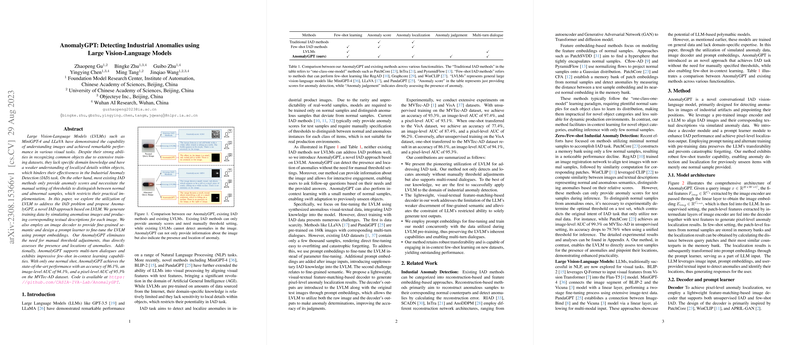AnomalyGPT: Detecting Industrial Anomalies Using Large Vision-LLMs
The paper "AnomalyGPT: Detecting Industrial Anomalies Using Large Vision-LLMs" introduces a novel approach to industrial anomaly detection utilizing Large Vision-LLMs (LVLMs). The paper leverages advancements in LVLMs like MiniGPT-4 and LLaVA, extending their capabilities beyond general recognition tasks to address the specific challenges of Industrial Anomaly Detection (IAD).
Key Contributions
AnomalyGPT combines LVLMs with an innovative strategy to effectively detect and localize anomalies in industrial contexts. Unlike conventional IAD methods that rely on manual threshold settings for anomaly detection, AnomalyGPT utilizes LVLMs, which inherently support natural dialogue interactions and exhibit a robust understanding of image content. This eliminates the need for subjective threshold adjustments and enhances practicality in real-world applications.
- LVLM-Based IAD Framework: AnomalyGPT introduces a framework wherein LVLMs are fine-tuned using a combination of simulated anomaly data and prompt learning. This enables the model to detect and localize anomalies without needing predefined anomaly thresholds. The incorporation of LVLMs in the process allows the system to interpret complex image-text relationships effectively.
- Enhanced Few-Shot Learning: The proposed framework supports few-shot learning, allowing it to adapt quickly to new or unseen industrial objects with minimal labeled data. In experimental evaluations, AnomalyGPT achieves state-of-the-art results in few-shot settings with a single normal image, reaching an accuracy of 86.1%, an image-level AUC of 94.1%, and a pixel-level AUC of 95.3% on the MVTec-AD dataset.
- Discussion of Limitations and Improvements: While LVLMs are powerful, they lack specific domain knowledge and sensitivity to localized details. AnomalyGPT addresses this by integrating a decoder module for finer semantic analysis and utilizing prompt embeddings to enhance the contextual understanding within the LVLM. This approach mitigates issues related to data scarcity and overfitting, often seen in domain-specific training.
Numerical Results and Discussion
The methodology of AnomalyGPT was tested on two widely recognized datasets: MVTec-AD and VisA, demonstrating superior performance in both unsupervised and few-shot scenarios. The paper reports an image-level AUC of 97.4% and pixel-level AUC of 93.1% in unsupervised settings on the MVTec-AD dataset, underscoring its efficacy and transferability across different industrial contexts.
Implications and Future Directions
AnomalyGPT's integration of advanced LVLMs into IAD presents significant implications for the evolution of automated quality control in manufacturing. By transcending the limitations of conventional anomaly detection methods, AnomalyGPT offers enhanced adaptability, reduced reliance on extensive labeled datasets, and the ability to engage in meaningful dialogues about image content and anomalies.
From a theoretical perspective, this paper opens avenues for exploring the convergence of vision, language, and anomaly detection. Future developments may involve enhancing the model's ability to learn from fewer samples while maintaining accuracy, further improving its application in dynamic production environments.
Conclusion
AnomalyGPT represents a significant step towards leveraging the capabilities of LVLMs in industrial applications. By addressing specific challenges in IAD with an innovative combination of anomaly simulation, prompt learning, and advanced LVLM features, the methodology sets a new standard for practical, robust, and scalable industrial anomaly detection solutions. This research exemplifies the potential for LVLMs to transcend conventional limitations and underscores the opportunities for further exploration in related domains.
